ZY-3A (Zi Yuan-3A)
EO
Imaging multi-spectral radiometers (vis/IR)
Land
Multi-purpose imagery (land)
Zi Yuan-3A (ZY-3A) is a high-resolution stereoscopic satellite of China, launched in January 2012. The satellite has objectives of high-accuracy mapping of Earth and resource investigations.
Quick facts
Overview
| Mission type | EO |
| Agency | CRESDA |
| Mission status | Operational (extended) |
| Launch date | 09 Jan 2012 |
| Measurement domain | Land |
| Measurement category | Multi-purpose imagery (land), Vegetation, Albedo and reflectance, Landscape topography |
| Measurement detailed | Land surface imagery, Vegetation type, Earth surface albedo, Land surface topography |
| Instruments | MUX (ZY-3-02), MUX (ZY-3-01), CCD (ZY Series) |
| Instrument type | Imaging multi-spectral radiometers (vis/IR) |
| CEOS EO Handbook | See ZY-3A (Zi Yuan-3A) summary |
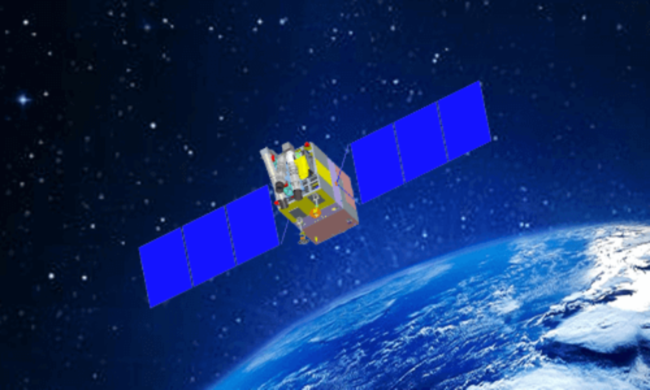
Summary
Mission Capabilities
ZY-3A is equipped with two multispectral radiometers, developed by the Changchun Institute of Optics, Fine Machinery and Physics (CIOMP). The TAC (Three-line Array Camera) is a CCD (Charge Coupled Device) pushbroom array imager composed of three high-resolution panchromatic cameras. The array obtains three-dimensional imagery of Earth’s surface, used for landscape topography and environmental monitoring.
MSC (Multispectral Camera) is a high-resolution, nadir-viewing visible/infrared (VIS/IR) imager. The instrument has multi-purpose imagery applications, including surveying Earth resources, land use and environmental monitoring.
Imagery obtained by ZY-3A has been widely used for map generation, including DSM (Digital Surface Model), DOM (Digital Orthographic Map), DEM (Digital Elevation Model), and DLG (Digital Linear Graphic).
Perfomance Specifications
TAC has spatial resolutions of 2.1 m for its nadir-viewing camera, and 3.5 m for the forward / backward cameras. The instrument has swath widths of 51 km for the nadir camera, and 52 km for the forward / backward cameras, as well as a spectral range of 500 - 800 nm.
MSC has a spatial resolution of 5.8 m, a swath width of 51 km and FOV of 6° x 0.3°. ZY-3A has a daily coverage of 150,000 km2 and a revisit period of 59 days, with the ability to revisit the same area within 4-5 days, in special cases. The instrument operates in four spectral bands: B1 (450 - 520 nm), B2 (520 - 590 km), B3 (630 - 690 nm) and B4 (770 - 890 nm).
The satellite has a positioning accuracy of less than 25 m, and is less than 2.28 m with GCPs (Ground Control Points) with an elevation accuracy less than 1.6 m with GCPs. The satellite is in a sun-synchronous near-circular orbit at an altitude of 506 km, inclined at 97.42°
Space and Hardware Components
ZY-3A is composed of a service module and a payload module; the service module provides the spacecraft structure, power generation, control and pointing services, data management subsystem, temperature maintenance, propulsion subsystem, and TT&C (Tracking Telemetry and Command) services. The payload module consists of the radiometer instruments, the DTS (Data Transmission System) and the image recording system.
The satellite has a mass of 2636 kg, and was designed and built by CAST/BISSE (China's Academy of Space Technology/Beijing Institute of Spacecraft System Engineering), from a modified ZY-2 platform. Communications from ZY-3A are transmitted in S-band frequency for TT&C and X-band frequency for payload data.
ZY-3A (Zi Yuan-3A)
Spacecraft Launch Mission Status Sensor Complement References
Overview
ZY-3A (Resource-3A) is the first civil high-resolution stereoscopic Earth mapping satellite of China. The overall objective is to compile a database for the production of 1:50000 and larger scale maps and to provide data for resource mapping, environmental surveying, disaster monitoring, city planning and national security needs. The ZY-3 project started in March 2008; it has come through the conceptual design and study phase, the prototype model development phase, and the flight model development phase in three and half years.
The mission requirements call for high-accuracy mapping. 1)
1) The satellite is required to have a positioning accuracy of 100 m without GCPs (Ground Control Points), in support of high-resolution mapping (1:50000 scale-based maps), a plane positioning accuracy of 25 m with GCP, and an elevation accuracy of 5 m. In order to obtain such elevation accuracy, it is also required to have extremely high orbit determination accuracy, attitude determination accuracy, onboard timing accuracy, interior orientation elements calibration accuracy, and stability.
2) Mapping and resource investigation. Since the satellite has the ability to generate multispectral imagery, the data can be used for territorial resource investigation and monitoring, and to provide services for disaster warning and reduction, agriculture, forestry, water conservation, ecological environment, and so on.
3) On-orbit high-stability interior orientation elements. The image point displacement caused by the change of interior orientation elements is required to be less than 0.3 pixels in half a year.
4) High-symbol-rate data transmission to the ground. The satellite adopts a high-speed modulation technology and a dual circular polarization antenna frequency reuse technology to achieve downlink transmission rate of 2 x 450 Mbit/s.
5) The design life of the mission is 5 years.

Spacecraft
The spacecraft is composed of a service module and a payload module. The service module provides support functions to the spacecraft such as structure and mechanisms, power generation, control and pointing services, data management subsystem, temperature maintenance, propulsion subsystem, and TT&C (Tracking Telemetry and Command) services. The payload module includes the sensor complement, the DTS (Data Transmission System), and the image data recording system. The three-line array camera is mounted on top of the spacecraft payload module, pointing toward Earth, as shown in Figures 1 and 3.
The ZY-3 (Zi-Yuan 3) satellite was designed and constructed by CAST/BISSE (China's Academy of Space Technology)/Beijing Institute of Spacecraft System Engineering) for the Chinese Ministry of Land and Resources (MLR), using a modified ZY-2 platform. The spacecraft is 3-axis stabilized. The ADCS (Attitude Determination and Control Subsystem) provides high agility for the spacecraft providing a pointing range in cross-track of ±32º. The pointing accuracy is ≤ 0.1º (triaxial, 3σ), the stability is ≤ 5 x10-4 º/s, and the drift angle correction accuracy is ≤ 0.1º (3σ, correction based on nadir camera).
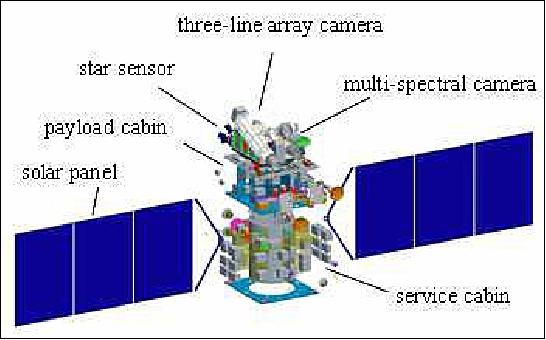
DTS (Data Transmission System): The DTS is composed of the data processing system and the data transmission channel to the ground, which is equipped with two data transmission channels of 450 Mbit/s. The three-line array camera adopts two selective compression ratios of either 2:1 or 4:1, while the multispectral camera adopts lossless compression.
The image recording subsystem is equipped with two solid-state recorders with 500 Gbit to record image data and original attitude measurement data. The DTS antenna subsystem is composed of two mechanical spot-beam antennas and the servo controller to transmit onboard data to the ground receiving station.
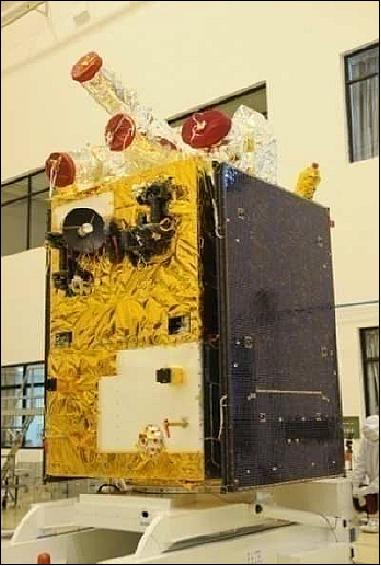
Spacecraft launch mass | 2636 kg |
Spacecraft design life | 5 years |
Spacecraft pointing capability in cross-track | ±32º |
Attitude control | - pointing accuracy is ≤ 0.1º (triaxial, 3σ) |
Onboard time synchronization accuracy | ≤50 µs |
Laser ranging | Onboard corner cube reflectors |
RF communications | - TT&C data are transmitted in S-band |
Three ground receiving stations for ZY-3 are located in Beijing, Kashi and Sanya, respectively. The satellite can collect 6 to 8 image strips everyday (about 1.8 TB), 3 to 4 of which are in China and 3 to 4 of which are distributed overseas. The imaging time per strip is about eight minutes, the coverage area is ~150,000 km2. 4) 5)
Launch
The ZY-3A spacecraft (also referred to as Ziyuan III 01) was launched on January 9, 2012 (03:17 UTC) on a Long March 4B vehicle from the Taiyuan Satellite Launch Center in China. The secondary payload on this flight was VesselSat-2, a microsatellite (mass of 29 kg) of Luxspace (OHB unit) with an AIS (Automatic Identification System) sensor complement for ship monitoring. 6)
Orbit: Sun-synchronous near-circular orbit, altitude = 506 km, inclination = 97.42º, orbital period = 97.716 minutes, LTDN (Local Time on Descending Node) = 10:30 hours. The satellite can cover all areas of the Earth between the latitudes of ±84º with a re-visiting period of 59 days. In special cases, the satellite can re-visit the same area in 4-5 days.
Mission Status
• January 17, 2020: China's first civilian high-definition mapping satellite Ziyuan III 01 has celebrated its 8th birthday in orbit. 7) 8)
- Despite its five-year design life, it continues to collect data, the Ministry of Natural Resources said Wednesday.
- Since it was launched in January 2012, the satellite has sent back 3D data covering 79 million km2 of the globe as of Dec. 31, 2019.
- It has enabled China to produce 1:50,000-scale maps, ridding the country's dependence on imports of satellite images, according to the ministry.
- The Ziyuan III 01 is tasked with providing data for the country's land-resources investigation, disaster prevention, agriculture development, environmental surveying and urban planning.
- The satellite has offered services to more than 40 countries and regions over the past eight years, the ministry said.
• The ZY-3A spacecraft and its payload are operating nominally in September 2015. 9)
• The ZY-3A spacecraft and its payload are operating nominally in 2013.
The ZY-3A imaging data offers good georeferencing performance and allows the generation of DSMs (Digital Surface Models) with much finer details than SPOT-5 HRS. 10)
• Fall 2012: Images obtained from ZY-3A have been widely used for map generation and to form mapping products such as DSM (Digital Surface Model), DOM (Digital Orthographic Map), DEM (Digital Elevation Model), and DLG (Digital Linear Graphic).
After the forward, nadir, and backward images have been adjusted based on GCP, the corresponding DSM of the current area (using the imagery of Figure 10 from January 2012) can be generated by using dense matching technology as shown in Figure 5. The generated DOM (of Figure 10) of the same region is shown in Figure 6 (Ref. 1).

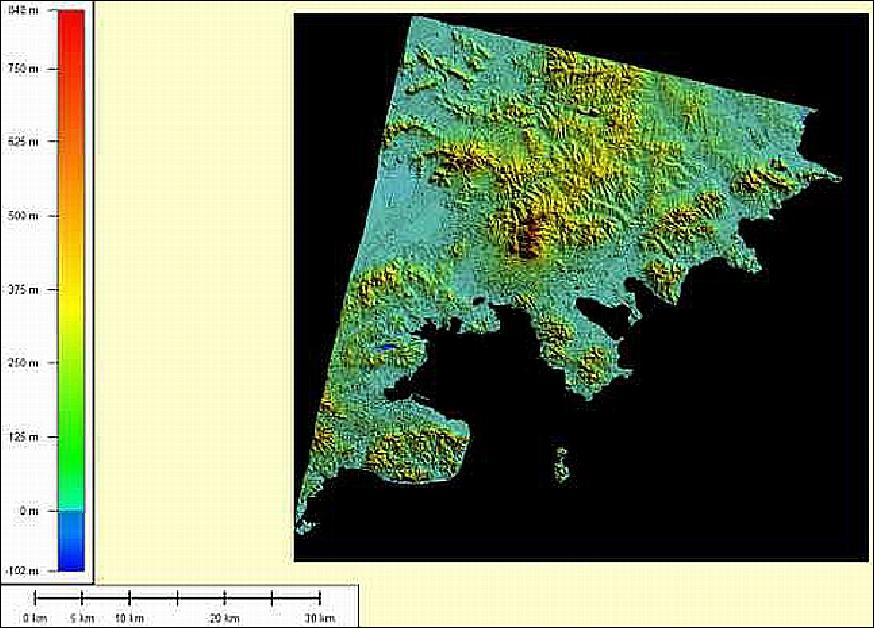
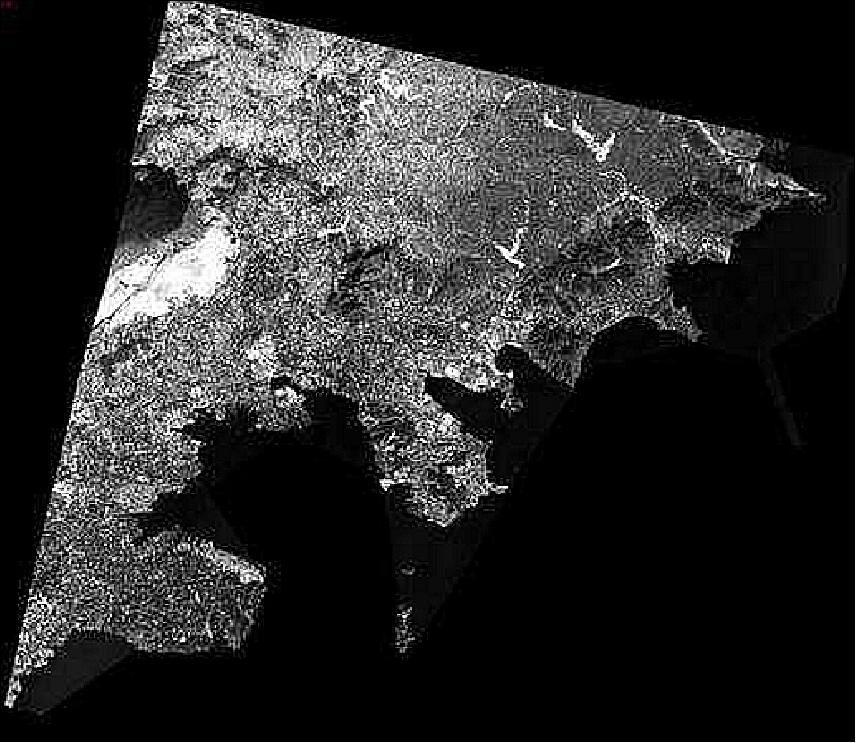
The DLG and red-green stereo images can then be generated. The DLG and red-green stereo image of the Dalian region are shown in Figures 7 and 8, respectively.
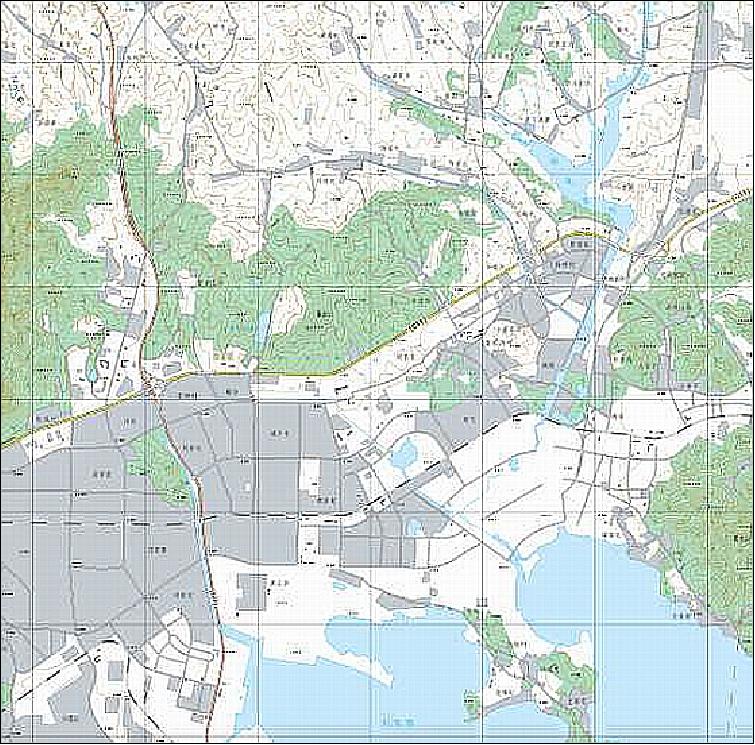
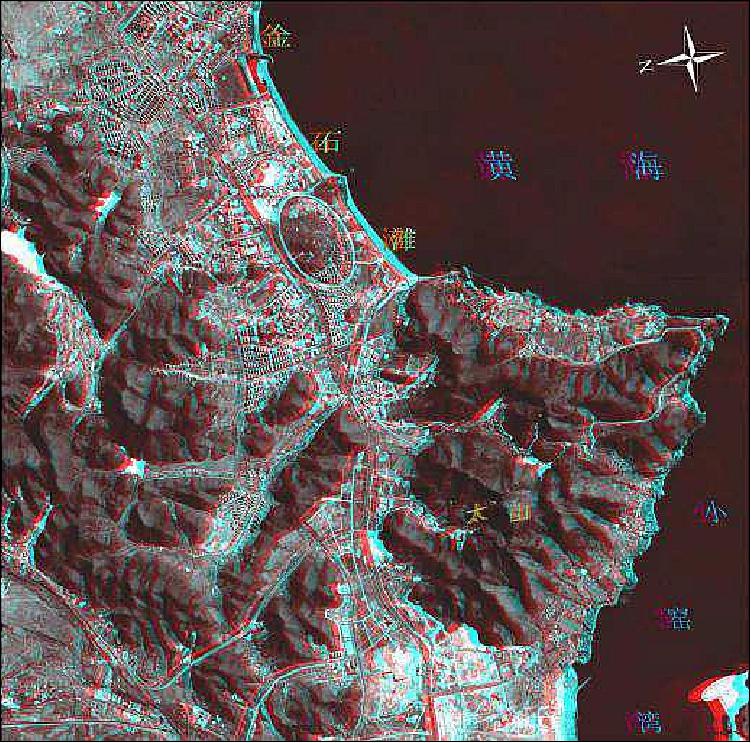
• All on-orbit tests of ZY-3 had been completed by April 20, 2012. The test results confirmed that the ZY-3 system functions and performance comply with the mission requirements; some key parameters, e.g. the positioning accuracy of the imagery, are better than the required values. This meant the ZY-3 spacecraft and its payload are operational, starting from April 20, 2012 (Ref. 1).
• From Feb. 9-18, 2012, 32 special mapping marks of the size of 40 m x40 m were located in a 50 km x10 km target region located in the north Anping county in the Hebei Province of China (Figure 9). The objective was to check the interior orientation elements and on-orbit MTF values of the mapping camera (TAC). The calibration accuracy in two directions with full control points after calibration, using interior orientation elements, were both better than 0.13 pixels. The on-orbit MTF values of the TAC assembly and the MSC (Multispectral Camera) were both > 0.12, meeting the mission requirements.
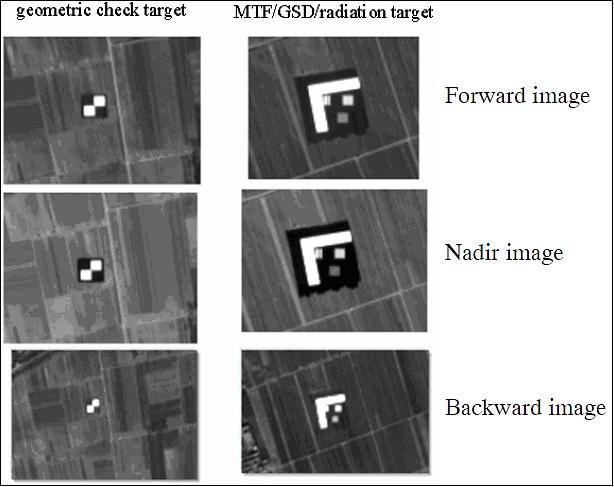
• On January 11, 2012, on the second day after launch, TAC of ZY-3 obtained an image of plain and hilly ground in the Dalian region of China of size 50 km x 50 km, shown in Figures 10 and 11. For the purpose of evaluation, the coordinates of 18 field control points have been measured on the ground. The accuracy was better than 0.1m, and the image point measurement accuracy was 0.5 pixel. The high-accuracy DOM (Digital Orthographic Map) was generated by using four control points, and the other 14 control points were used as checkpoints to obtain the nominal values of the external orientation elements. - Using the nominal values of the external orientation elements on the first round on-orbit and evaluation method with GCP, the positioning accuracy with and without GCP has been analyzed for flat ground, mountainous ground, alpine ground, and so on. The results show that the positioning accuracy was less than 25 m without GCP. In fact, the plane ground accuracy turned out to be better than 2.28 m with GCP, and the elevation accuracy was better than 1.6 m.
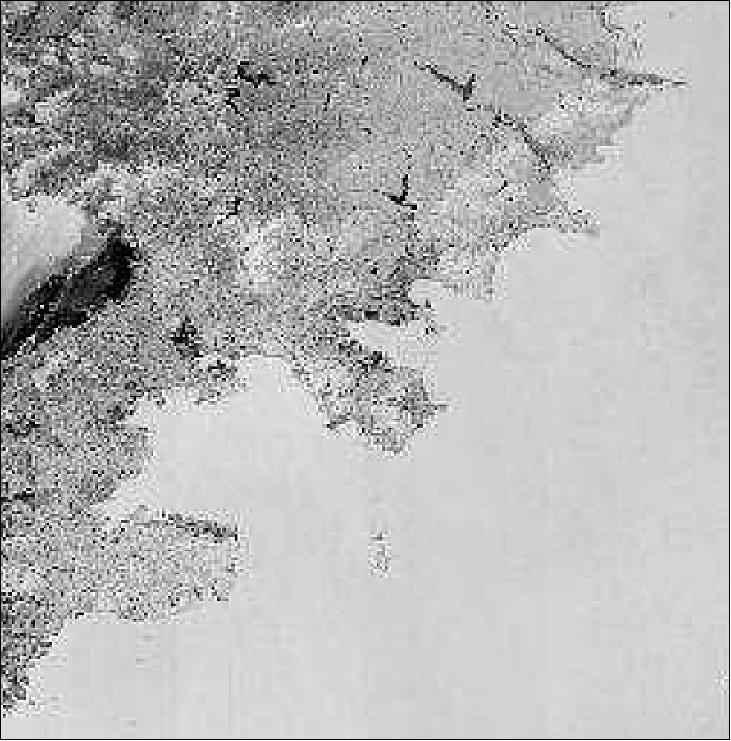
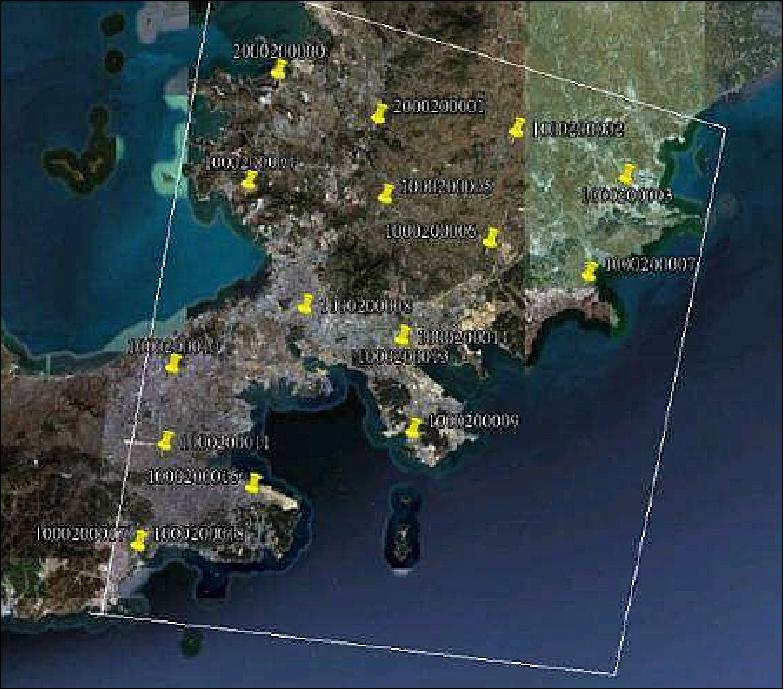
Sensor Complement
The sensor complement was developed by the Changchun Institute of Optics, Fine Machinery and Physics (CIOMP). The electro-optical payload package was designed to obtain three-dimensional imagery of Earth's surface using three high-resolution panchromatic cameras positioned 22° from each other to face forward, nadir, and backwards onto the subsatellite track (Ref. 1).
TAC (Three-line Array Camera)
The three-line observation concept results in forward, nadir and aft views of the CCD pushbroom array. The TAC assembly consists of three cameras and telescopes, a control unit, and signal processing units, all integrated into a support frame (Figure 12). The TAC instrument and the star sensor are accommodated on the integrated support frame to form an assemblage (optical bench), mounted on the top of the satellite payload cabin.
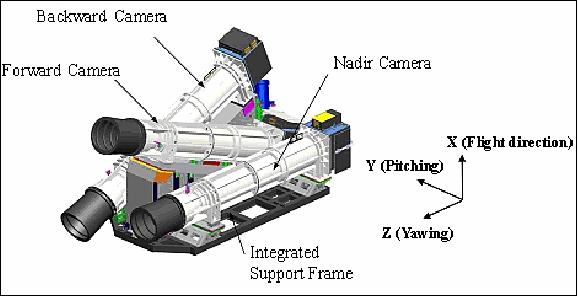
Spectral range | 500~800 nm |
FOV (Field of View) | ≥6º |
Swath width | Nadir camera: 51 km |
Absolute distortion | No distortion |
GSD (Ground Sample Distance) at nadir | Nadir camera: 2.1 m |
Focal length of telescope | 1700 mm |
MTF (Modulation Transfer Function), average value in full FOV | Nadir camera: 0.23 (71.5 lp/mm) |
SNR (Signal-to-Noise Ratio), dynamic range | ≥ 25 (θ=30º, ρ=0.03) |
Data quantization | 10 bit |
On-orbit stability | Image point displacement caused by the change of interior orientation elements is less than 0.3 pixels, (2.1 µm) in half a year |
Design life | 5 years |
The following key technologies have been developed for the TAC (Three-line Array Camera) assembly: 11)
1) High image quality and high stability telescope unit: To achieve high precision stereo mapping mission, the mapping camera telescope unit is required to have excellent image quality, minimal distortion and stable interior orientation elements (Table 2). The imaging quality can be effectively improved by increasing the MTF value, reducing distortion, and suppressing of the stray light. On the other hand, the stability of imaging quality and interior orientation elements can be greatly improved by selecting the proper optical system, increasing the 1st order frequency of the telescope unit, adopting an accurate thermal control design, and isolating the camera on the integrated support frame. Some design measures have been adopted as follows.
• Selection of a refractive quasi-telecentric optical system in image space. Without obscuration, the refractive optical system can easily obtain a larger FOV and higher MTF value than a reflective system. Moreover, for the refractive system, the axial (Z direction) dimension is somewhat large though; the radial (Y direction) dimension is reduced obviously, which is of benefit to the arrangement of TAC in the Y direction. Based on the analysis of a general ideal optical system with regard to thermal stability, it is observed that the telecentric optical system in image space has better thermal stability than other systems.
• The design of the telescope unit support structure shall ensure that the variation of image quality and stability, caused by vibration during the launch phase, followed by an on-orbit zero-g environment and on-orbit thermal environment change, remains within the range limits. Titanium alloy was selected for the telescope unit structure in order to provide a satisfactory design for the optical system and to reduce thermal stress at the same time. The stray light coefficient can be controlled in the required value by mounting a baffle in the front, locating a proper stray light elimination stop, and controlling the absorptivity and roughness of the inner cylinder.
A vacuum outgassing test has been performed after the telescope unit alignment in order to be adapted to the on-orbit vacuum environment and the zero-gravity environment. The MTF of the telescope unit was subsequently tested in three operation conditions, i.e., parallel, turning 180°, and perpendicular to the optical axis. The results showed that the MTF value is almost constant.
• The thermal isolation mounting method was adopted to assemble the telescope unit and the integrated support frame in order to reduce any temperature gradients between them. One end of the telescope unit was designed as a flexible support, able to decouple the structure and release thermal deformation. The test results showed that when the temperature was raised by 2°, such a structure can release 98.6% of the thermal deformation along the optical axis; hence, the change of the optical axis angle was < 1 arcsec.
• High-accuracy thermal control design: Although the above methods have been used, a high-accuracy thermal control design is still necessary to obtain higher stability. Both an active and a passive thermal control method have been adopted, by which the temperature of the telescope unit met the requirement of 20°C±1°C, the maximum radial temperature difference of the lens was < 0.2°C, and the maximum radial temperature difference fluctuation was < 0.1°C.
2) High-stability integrated support frame (optical bench): The star sensor is mounted on the integrated support frame to improve the attitude determination accuracy of ZY-3. A high-accuracy active temperature control method has also been applied to the star sensor assemblage, the integrated support frame, and the satellite crown plate. During the course of the integrated support frame design, two requirements shall be considered.
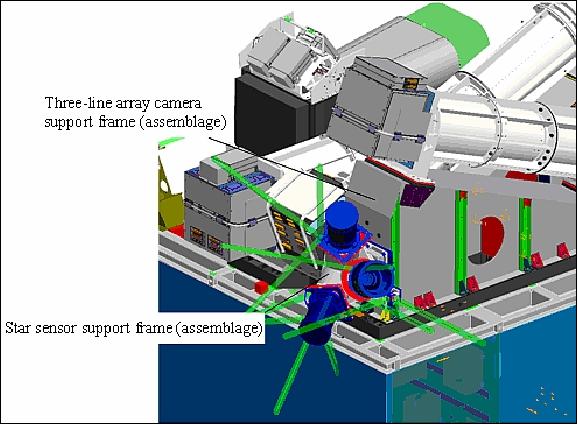
• Stability shall be high enough to ensure that the angles between cameras and between the camera and the star sensor be stable on-orbit. The integrated support frame is mainly composed of the forward camera support, the backward camera support, the nadir camera support, and the support frame base. Due to its extra-low hygroscopicity, high thermo-tolerance, excellent dimensional stability, good mechanical property, and the moulding processing property similar to epoxide resin, the CE (Cyanate Ester) carbon fibre composite is selected for the forward and backward camera supports to obtain the required stability and reduce mass. The thermal insulation mounting method has been adopted for connection between the star sensor support frame and the backward camera support, and between the support frame base and the satellite crown plate. The active temperature control method has been adopted for the star sensor assemblage, the integrated support frame and the satellite crown plate used respectively in order to reduce temperature fluctuation and therefore minimize the structural distortion caused by thermal stress.
• Stiffness shall be high enough to provide reliable support for the camera assemblage and the star sensor during the launch phase. Titanium alloy is used for the support frame base, which is optimized topologically to obtain a high specific stiffness. In order to achieve an optimal plan, the number and position of stiffeners on the forward/backward camera supporting assembly and its material spreading, the mounting positions between the integrated support frame and the satellite have been optimized by modelling analysis. The complete system modal analysis has been simulated by using the frequency correlation and mode correlation methods. The results show that the camera's basic frequency is greater than 70Hz, which complies with the vibration test result.
3) High-speed and low-noise video circuit: The video circuit is mainly composed of the focal plane circuit and the signal processing unit. Both the forward and backward cameras adopt 10 µm pixel panchromatic TDI (Time Delay Integration CCD /Charged Coupled Device) array detectors; the nadir camera uses 7 µm pixel panchromatic TDI CCDs. The TDI CCD line array is formed by splicing the devices onto a half-reflection and half-transmission prism.
• The 7 µm pixel panchromatic TDI CCD detector is used due to its high MTF, excellent radiation response characteristics, and anti-blooming structure, which can avoid peripheral pixel saturation caused by local pixel saturation, and obtain good image quality.
• The 10-bit A/D quantization signal processing technology and the FPGA of 106 system gates have been used in order to achieve a high-integration, low-power-consumption, and low-noise imaging circuit design.
• Various methods have been adopted, e.g., sufficient hardware simulation for hybrid analogue-digital circuits, optimization of circuit board layout and wiring, adoption of LC filtering network to suppress the power interference, so that noise caused by circuits is better than 1 LSB, the image noise has been reduced greatly and more details can be visible.
• The onboard dynamic clamping technology has been adopted for parameter setup on-orbit in order to remove the image substrate caused by atmospheric diffusion and reflection and improve image quality.
4) High-accuracy time calibration technology: The high-resolution stereo mapping camera is required to have a higher time accuracy to obtain a higher positioning accuracy. When the TAC starts the imaging mode, it receives simultaneously both the hardware PPS from the GPS subsystem and the corresponding integral second-time data transmitted by the data management subsystem. The local timer is started up by the signal processing unit according to hardware PPS in order that the imaging time of each line can be computed accurately and marked into auxiliary data of the corresponding image line. The minimum time scale for the recording of the imaging time is 1µs, and the system error is less than 20 µs. 12)
5) High accuracy interior orientation elements and angle testing technology: To the basis for post-image analytic processing, it is necessary to accurately measure the interior orientation elements and included angles among the three cameras. The interior orientation elements mainly include the principal point, principal focal length, image distortion, etc. The measured camera is mounted on a 2D rotary table through a special support frame. The testing target is imaged on the focal plane of the camera through a collimator. The data collection and processing system is used to compute the centroidal displacement of the target image. The rotating angle of the camera is tested by a special angle measurement device. Finally, the camera's principal focal length and the distortion distribution in each FOV can be computed.
Multispectral Camera
The Multispectral Camera (MSC) is composed of the electrooptical assembly, the management and control unit, and the signal processing unit. The electro-optical assembly includes an off-axis TMA (Three Mirror Anastigmat) optical telescope unit, the focal plane assembly, and the baffle (Figure 14). A high-stiffness main body frame is used to connect four reflection mirror assemblies with the focal plane assembly to form a stable optomechanical assembly, which is then connected to the satellite top frame by the thermal-unloading flexible structure. The camera can be focused by adjusting the focal plane position resulting from the adjustment of the flat mirror assembly position (Ref. 1).
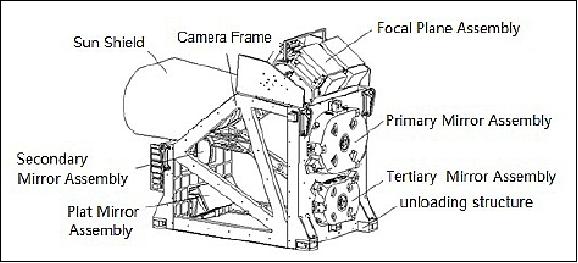
Spectral range | B1: 450~520 nm |
FOV (Field of View) | 6º x 0.3º |
Swath width at nadir | 51 km |
GSD (Ground Sample Distance) | 5.8 m |
Focal length | 1750 mm |
MTF (Modulation Transfer Function) average value in full FOV | B1, B2, B3: 0.25 (25 lines/mm) |
SNR (Signal-to-Noise Ratio), dynamic range | ≥ 100 (θ=70º, ρ=0.3) |
Data quantization | 10 bit |
Design life | 5 years |
The following key technologies have been developed for the MSC (Multispectral Camera) assembly:
1) Optical system technology: The MSC adopts the off-axis TMA optical system design with a quasi-telecentric light path in the image space and the flat field; this has the advantages of a large field of view, no obscuration, high MTF, and so on. By optimizing the optical structure parameters, the primary mirror and the tertiary mirror are designed to be off-axis aspheric, which enables a low distortion in full FOV and obtains images which are close to the diffracting limit. The optical system tolerance has been optimized so that when the reflecting mirror is inclined to 50 µrad or translated to 40 µm, the MTF value reduces by only 0.01. The change of distances between the mirrors has little effect on the focal plane, image surface position, and MTF. Therefore, such low tolerance requirement will reduce the difficulties of structure design, manufacturing and alignment.13) 14)
2) Off-axis reflecting mirror unloading mounting technology: The ZERODUR® (Zero Expansion Glass-Ceramic) product of Schott has been selected for the reflecting mirrors, providing good thermal stability whenever radial temperature gradients exist inside the mirror. Invar material, whose thermal expansion coefficient matches that of glass ceramics, is cemented into the mounting hole of the reflecting mirror. Titanium alloy is selected for the supporting structure. The reflecting mirror adopts a four-point spherical hinge mounting. The holding device from the bulbs is designed to be located on the centroidal surface of the reflecting mirror (Figure 15). The decoupling freedom of the four bulbs can be used to achieve statically determinate constraints to six degrees of freedom of the reflecting mirrors, e.g., the back centre bulb is used to constrain the mirror translation perpendicular to the optical axis, the other three side bulbs are used to constrain the translation and rotation of the mirror along the optical axis.
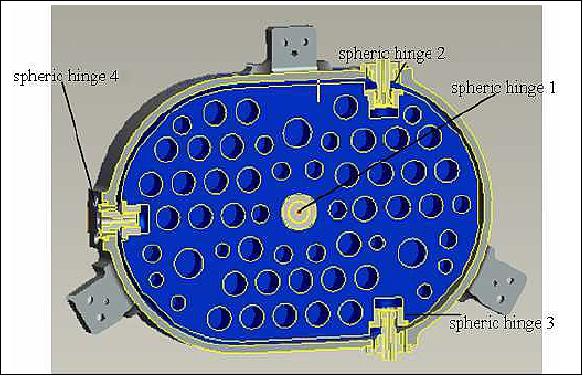
Results from a simulation analysis and tests show that the basic frequencies of the off-axis reflecting mirror assemblies are all greater than 200 Hz, and the surface change compared to bare mirrors is < 0.003 λ under the conditions of gravitation and 20°C±3°C, which complies with the required parameters.
3) High speed and low noise circuit technology: The MSC adopts 20 µm CCD detectors and a TDI operation mode. A low-temperature control method has been used to reduce the dark current of the detector array by mounting four highly efficient micro heat pipes at the back of the CCD detector arrays; thus, the temperature of the CCD detector arrays is kept in the range of -15°C to +5°C which greatly reduces the black current level and the corresponding noise generated by devices. The circuit design is similar to the TAC assembly, where the onboard digital gain and dynamic clamping technology are adopted to achieve a highly integrated level, low-power consumption, and low-noise circuit design. The maximum SNR measurement values of each spectrum are all better than 51 dB. The imaging time of each image frame can be calibrated accurately based on GPS/PPS (Global Positioning System/Precise Positioning System) hardware, satellite integral second counting and camera local timer, and the positioning accuracy can therefore be improved. The test results show that the time calibration accuracy is better than 20 µs.
4) Alignment and test technology: The optical system alignment and test includes two basic functions, i.e., reflecting mirror alignment and test, and optical system alignment and test. The difficulties of a mirror test involve the off-axis aspherical mirror test and the convex secondary mirror test, including the determination of the non-circular area Zernike coefficient; furthermore, there are the measurements of the climax curvature radius, aspherical coefficient and vector height; precise measurement of off-axis value; design, manufacturing and alignment error correction of the compensator, etc.. - The alignment factor is greater than 92% (Ref. 1).
A stable truss structure was chosen for the main structure of the telescope as shown in Figure 16. CFRP (Carbon Fiber Reinforced Plastic) a very light material with an extremely low coefficient of thermal expansion was used for the manufacture of the truss beams. A high volume fraction SiC/Al material, which has high stiffness and excellent thermal conductance, was used for the front and back frames. With the technologies of topology optimization and finite element analysis, the total mass of the whole structure is 30% less than a normal telescope, featuring high mechanical and thermal stability (Ref. 14).
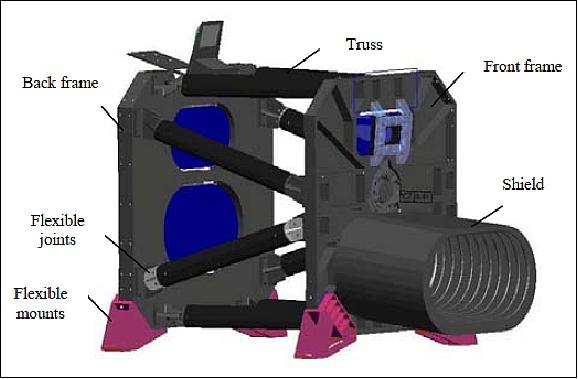
The entire telescope ((including mirrors, structure, baffles and a focal plane) has a mass of < 60 kg. The first frequency of the telescope is higher than 120 Hz, working within a temperature range of 20±5ºC. The focal plane location remains stable and the maximum reduction of the telescope MTF is less than 0.02 without any focal plane adjustment (Ref. 14).
Ground Segment
Onboard data processing and data transmission
The payload source data rate is > 2 Gbit/s; hence, a high-speed data compression algorithm and corresponding modulation technology were adopted by the DTS (Data Transmission System). The camera imagery is compressed by the lossless JPEG algorithm, and then divided into two channels to perform QPSK (Quadra-Phase Shift Keying) modulation with a symbol rate of 450 Mbit/s. The DTS antenna uses the dual circular polarization reuse technology to radiate these data to the ground receiving station through the same high polarization isolation spot-beam antenna. The high-accuracy tracking technology has also been used for the spot-beam antenna.
After the launch of the spacecraft, a PN (Pseudo Noise) code signal transmission test with the dual channel configuration and a symbol rate of 450 Mbit/s has been performed between the satellite and the Miyun ground station in Beijing. The left/right-hand circular polarization signals transmitted from the satellite have been successfully captured and tracked by the ground station. Error rates in the two channels are both 0 after real-time demodulation, which indicates that the high-speed dual circular polarization data reuse transmission technology had been implemented successfully. During on-orbit operation, a lot of imagery has been transmitted to the ground by the DTS, in real-time transmissions as well as in dual-channel playback, to ensure the proper operation of the mapping mission (Ref. 1).
References
1) Haiyi Cao, Weijun Gao, Xinwei Zhang, Xigang Liu, Bin Fan, Shaohui Li, “Overview of ZY-3 satellite research and application,” Proceedings of the 63rd IAC (International Astronautical Congress), Naples, Italy, Oct. 1-5, 2012, paper: IAC-12-B1.3.3
2) “Ziyuan 3,” Dragon in Space, April 3, 2012, URL: http://www.dragoninspace.com
/earth-observation/ziyuan3.aspx
3) “China's First Civil High-resolution Stereo Mapping Satellite ZY-3 Operates Stably in Orbit,” ISPRS e-bulletin, April 2012, URL: http://www.isprs.org/news/newsletter/2012-02
/51_Chinas_First_Civil_High-resolution_Stereo_Mapping_Satellite.pdf
4) Xinming Tang, “An Introduction of ZY-3 Satellite,” An Introduction of ZY-3 Satellite,” Proceedings of the 22nd Congress of ISPRS (International Society of Photogrammetry and Remote Sensing), Melbourne, Australia, Aug. 25 - Sept. 1, 2012, URL of abstract: http://www.isprs2012.org/abstract/1829.asp
5) Chengzhi Sun, Xinming Tang, Zhenge Qiu, Xiaoliang Wu, “Introducing ZY-3: China’s First Civilian High-Res Stereo Mapping Satellite,” Proceedings of the 22nd Congress of ISPRS (International Society of Photogrammetry and Remote Sensing), Melbourne, Australia, Aug. 25 - Sept. 1, 2012, URL of abstract: http://www.isprs2012.org/abstract/952.asp
6) “Ziyuan-3 and VesselSat-2, Long March 4B, January 9, 2012,” URL: http://orbiter-forum.com
/showthread.php?p=328835
7) ”China's first civilian HD mapping satellite in service for eight years,” Space Daily, 17 January 2020, URL: http://www.spacedaily.com/reports
/Chinas_first_civilian_HD_mapping_satellite_in_service_for_eight_years_999.html
8) ”China's first civilian HD mapping satellite in service for eight years,” China Daily, Xinhua, 16 January 2020, URL: https://www.chinadaily.com.cn/a/202001/16/WS5e1fca96a3101282172715ff.html
9) ”China Integrated Earth Observation System(2016-2025) - China GEO 2025 Expert Group,” Sept. 9, 2015, URL: http://tinyurl.com/z28l4f9
10) Pablo d’Angelo, “Evaluation of ZY-3 for DSM (Digital Surface Model) and ortho image generation,” International Archives of the Photogrammetry, Remote Sensing and Spatial Information Sciences, Volume XL-1/W1, ISPRS Hannover Workshop 2013, 21 – 24 May 2013, Hannover, Germany, URL:
http://www.int-arch-photogramm-remote-sens-spatial-inf-sci.net/XL-1-W1/57/2013/isprsarchives-XL-1-W1-57-2013.pdf
11) Wenjun Cai, Bin Fan, Fengqin Zhang, Qinglin Li, Xin Wei, “An Effective Unloading Opto-structure Design of Multi-Spectral Camera on ZY-3,” Proceedings of SPIE Remote Sensing 2012, 'Sensors, Systems, and Next-Generation Satellites,' Edinburgh, Scotland, UK, Vols. 8531-8539, Sept. 24-27, 2012, paper: 8533-32
12) Shenghui Fang, Yifu Chen, “Sensor Calibration of Three-line CCD Scanners on ZY-3,” Proceedings of the 22nd Congress of ISPRS (International Society of Photogrammetry and Remote Sensing), Melbourne, Australia, Aug. 25 - Sept. 1, 2012, URL: http://www.int-arch-photogramm-remote-sens-spatial-inf-sci.net
/XXXIX-B1/109/2012/isprsarchives-XXXIX-B1-109-2012.pdf
13) Bin Fan, Weijun Cai, Ying Huang, Wenchun Jiao, “Research of the multispectral camera of ZY-3 satellite,” Proceedings of SPIE Remote Sensing 2012, 'Sensors, Systems, and Next-Generation Satellites,' Edinburgh, Scotland, UK, Vols. 8531-8539, Sept. 24-27, 2012, paper: 8533-31
14) Bin Fan, Wei-jun Cai, Ying Huang, “Design and Test of a High Performance Off-axis TMA Telescope,” Proceedings of the ICSO (International Conference on Space Optics), Ajaccio, Corse, France, Oct. 9-12, 2012, paper:ICSO-038, URL: http://congrex.nl/icso/2012/papers/FP_ICSO-038.pdf
The information compiled and edited in this article was provided by Herbert J. Kramer from his documentation of: ”Observation of the Earth and Its Environment: Survey of Missions and Sensors” (Springer Verlag) as well as many other sources after the publication of the 4th edition in 2002. - Comments and corrections to this article are always welcome for further updates (eoportal@symbios.space).
Spacecraft Launch Mission Status Sensor Complement References Back to top